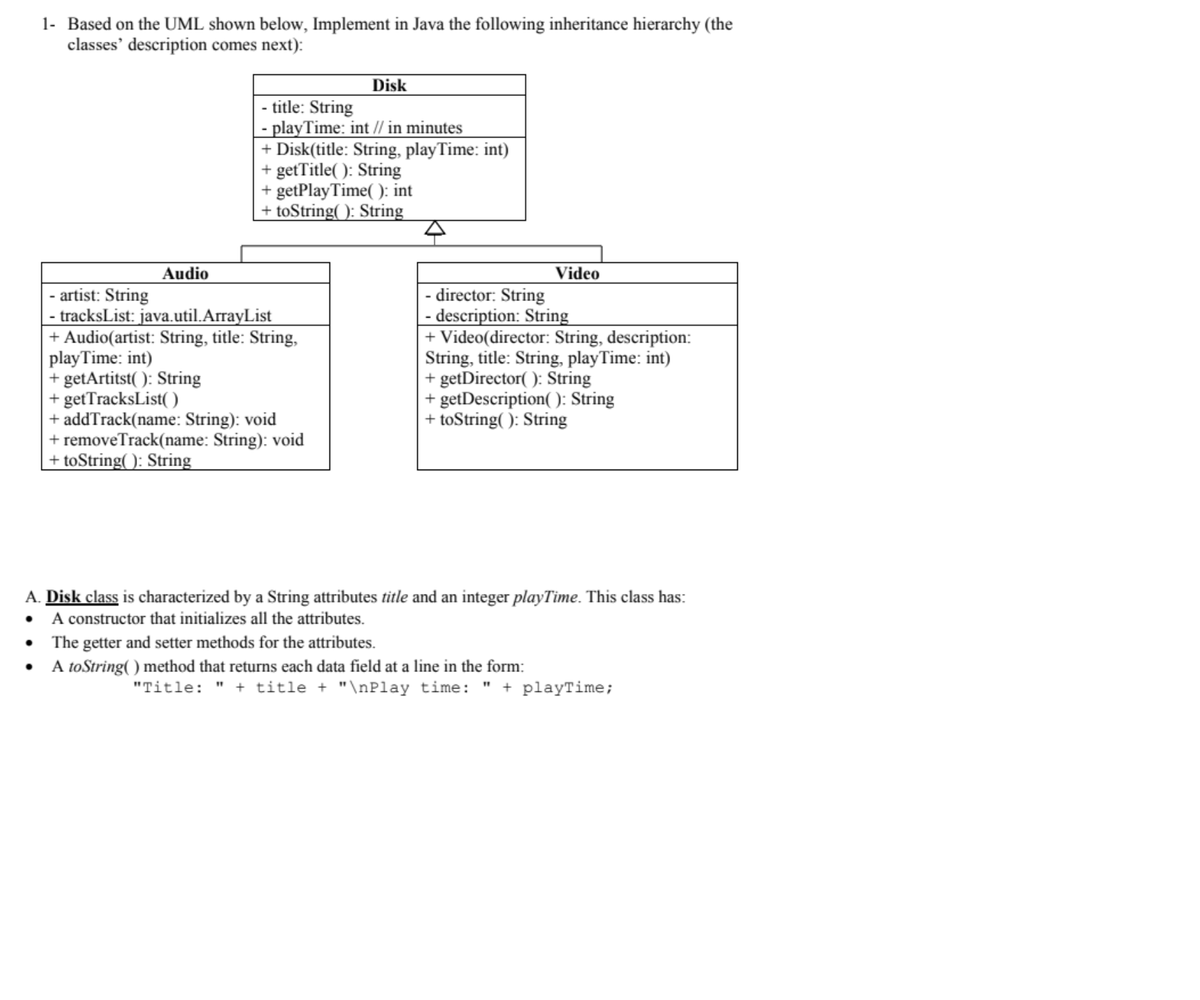1- Based on the UML shown below, Implement in Java the following inheritance hierarchy (the classes' description comes next): Disk -title: String -playTime: int // in minutes + Disk(title: String, playTime: int) + getTitle(): String + getPlayTime(): int + toString(): String 4 Audio Video -artist: String - director: String - tracksList: java.util.ArrayList - description: String + Audio(artist: String, title: String, play Time: int) + Video(director: String, description: String, title: String, playTime: int) + getArtitst(): String + getDirector(): String + getTracksList() + getDescription(): String + toString(): String + addTrack(name: String): void + removeTrack(name: String): void +toString(): String A. Disk class is characterized by a String attributes title and an integer playTime. This class has: A constructor that initializes all the attributes. • The getter and setter methods for the attributes. ● A to String() method that returns each data field at a line in the form: "Title: " + title + "\nPlay time: " + playTime;
1- Based on the UML shown below, Implement in Java the following inheritance hierarchy (the classes' description comes next): Disk -title: String -playTime: int // in minutes + Disk(title: String, playTime: int) + getTitle(): String + getPlayTime(): int + toString(): String 4 Audio Video -artist: String - director: String - tracksList: java.util.ArrayList - description: String + Audio(artist: String, title: String, play Time: int) + Video(director: String, description: String, title: String, playTime: int) + getArtitst(): String + getDirector(): String + getTracksList() + getDescription(): String + toString(): String + addTrack(name: String): void + removeTrack(name: String): void +toString(): String A. Disk class is characterized by a String attributes title and an integer playTime. This class has: A constructor that initializes all the attributes. • The getter and setter methods for the attributes. ● A to String() method that returns each data field at a line in the form: "Title: " + title + "\nPlay time: " + playTime;
Chapter11: Advanced Inheritance Concepts
Section: Chapter Questions
Problem 16RQ
Related questions
Question

Transcribed Image Text:1- Based on the UML shown below, Implement in Java the following inheritance hierarchy (the
classes' description comes next):
Disk
- title: String
- playTime: int // in minutes
+ Disk(title: String, playTime: int)
+ getTitle(): String
+ getPlay Time(): int
+ toString(): String
Audio
Video
- artist: String
- director: String
· tracksList: java.util.ArrayList
- description: String
+ Audio(artist: String, title: String,
+ Video(director: String, description:
play Time: int)
String, title: String, playTime: int)
+ getArtitst(): String
+ getDirector(): String
+ getTracksList()
+ getDescription(): String
+ addTrack(name: String): void
+ toString(): String
+ removeTrack(name: String): void
+ toString(): String
A. Disk class is characterized by a String attributes title and an integer playTime. This class has:
• A constructor that initializes all the attributes.
•
The getter and setter methods for the attributes.
•
A to String() method that returns each data field at a line in the form:
"Title: " + title + "\nPlay time: " + playTime;
Expert Solution
This question has been solved!
Explore an expertly crafted, step-by-step solution for a thorough understanding of key concepts.
Step by step
Solved in 2 steps with 3 images

Knowledge Booster
Learn more about
Need a deep-dive on the concept behind this application? Look no further. Learn more about this topic, computer-science and related others by exploring similar questions and additional content below.Recommended textbooks for you

EBK JAVA PROGRAMMING
Computer Science
ISBN:
9781337671385
Author:
FARRELL
Publisher:
CENGAGE LEARNING - CONSIGNMENT

EBK JAVA PROGRAMMING
Computer Science
ISBN:
9781337671385
Author:
FARRELL
Publisher:
CENGAGE LEARNING - CONSIGNMENT